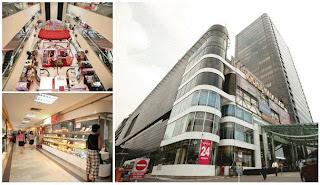 My investments in S-REITs are holding up nicely which gives credence to my strategy to overweight S-REITs in my portfolio. Their relative price stability and high distribution yields provide some solace in a volatile market.
My investments in S-REITs are holding up nicely which gives credence to my strategy to overweight S-REITs in my portfolio. Their relative price stability and high distribution yields provide some solace in a volatile market.
A brief look at some of my larger investments in S-REITs:
1. AIMS AMP Capital Industrial REIT closed at $1.20 per unit. My cost per unit ranges from $0.775 to $1.10.
2. Sabana REIT closed at $0.97 a unit. I first initiated a long position at $0.93 in March 2011. I bought more as its unit price sank below $0.90. I am still holding on to those units I bought at $0.865.
3. First REIT closed at $0.90 a unit. This is an investment I have had for many years. My lowest entry price was $0.42 during the global financial crisis. I took part in its rights issue at $0.50 a unit. I bought more nil-paid rights for a total cost of $0.66 a unit. I also bought more units at $0.70+c.
4. LMIR closed at $0.39 a unit. Like First REIT, this is an investment I have had for many years. My lowest entry price was $0.185 during the global financial crisis. I took part in its rights issue at $0.31 a unit. I also bought more nil-paid rights for total cost of $0.331 to $0.365 a unit.
5. Saizen REIT closed at $0.143 a unit. The history I have had with this REIT is somewhat bumpy. I increased my long position once again with a large purchase as its warrants reached their last day of trading not too long ago. Average price of that purchase $0.129.

I have collected many quarters of income distributions from these investments and my war chest is constantly being refilled. So, I constantly have funds to take advantage of any investment opportunities which might come along.
My strategy is to stay partially invested as we must also have cash to continue investing especially if Mr. Market decides to sell good quality stocks and trusts at bargain basement prices.

Recent efforts to invest in some companies instead of S-REITs have produced below average results. In fact, my poorly timed investments in China Minzhong and Wilmar, although relatively small, are a drag on my portfolio's performance. If I had stuck to my strategy of concentrating on S-REITs in recent times, my porfolio would have fared much better.
Of course, there would be people who disagree. Readers who comb the cyberspace for information would have, no doubt, come across some local blogs which vilify REITs. Well, everyone is entitled to his own opinions.
I have gotten somewhat tired of defending my position. Actually, why do I even need to defend my strategy? If people like it, they are welcome to follow. If they don't like it, don't follow. This is a free world. Just don't be rude.
I was never a savvy person with IT stuff and when I discovered blogging, I was like a child who discovered the sweetness of sugar. I got a sugar high. I have always enjoyed writing. So, I took to blogging like a fish to water. Also, as I age, I have developed an increasingly serious speech impediment. To a rather talkative person, this is an annoyance and makes blogging even more of an outlet of expression.
Making money from blogging was never a first thing on my mind. It came about later on when friends suggested that I could put some ads in my blog. I must say that I have been able to make some pocket money this way. Pocket money? Hey, Nuffnang pays me 20c for every click I get for ads they place on my blog. If my primary motivation for starting this blog is to make money, I must be seriously mental.
If I were to stop blogging tomorrow, what would I lose in monetary rewards?
Well, I have been thinking of taking a break from blogging and I have shared this thought here in my blog as well. There are other aspects of my life I would like to spend more time on. There are also people I would and should spend more time with. It is also quite obvious to regular readers that I have been blogging less frequently too.
We often hear of the saying that "this is the last straw that broke the camel's back". Well, I think I got another catalyst to stop blogging at least for a while earlier this evening.
To my regular readers, you know which blog posts I have here in my blog which would keep you squarely on your goal of financial freedom. Each time you waver, come back to my blog and go down the right sidebar. I would also be doing the same, no doubt. It is not easy to start but start we must. The journey is hard but go on we must. When we see the results of our effort, it would get easier and easier. Remember, if AK71 has done it, you can too.

To new readers, understand that we are all different. Not everyone can be a Warren Buffet or Donald Trump or Robert Kiyosaki. They have all taken their own paths to success. You should find your own. Reading my blog, if you feel that my way is something you would like to emulate, give it a go but know that everyone's circumstances are different. Set for yourself realistic goals. Take baby steps but you have to work towards building up passive income to a level that is equal to or exceeds your earned income. Then, you would have achieved financial freedom and you work because you want to and not because you have to.
In everything we do, there is an element of luck. Even Warren Buffet was wrong before. No one is God and even with Him, there is debate on things He might have done wrong. OK, this is a sign that I should stop. Yes, Father, I have sinned.
----------------
The following was a blog post written on 28 November 2011 after talking to "ao" in LP's infamous cbox (Bully the Bear). It was never published... till now:
A reader asked me recently if I ever get tired of replying to comments in my blog, especially with skeptics aplenty when it comes to my investments in REITs. I told him that I am only human and I do feel tired sometimes.
Recently, I had lunch with the blogmaster of Time to Huat and another long time friend. They asked the same thing, almost. One of them said that some comments were almost repetitive and marvelled at my patience in replying to every comment even so.
To me, I feel that if a job is worth doing, it is worth doing well. How do we measure worth? In the world of blogging, at least to me, it is not measured in dollars and cents. I would be better off giving private tuition with my time, using such a measure.
When I started blogging, I took on certain responsibilities whether I knew it at that point in time or not. I am airing my thoughts in cyberspace. I am sharing ideas. Of course, there will be questions and also disagreements. What is a blogger to do? Face these squarely.
Being a blogger is like being a semi public figure. Semi public? Yes, we can choose to blog without revealing our true identity. I have gotten a taste of what it is like to be a semi public figure and I doubt I would ever want to be a public figure. So, although I have met a handful of readers and fellow bloggers so far, I have decided quite some time back to be more reclusive. I value my privacy too much to ever become a public figure.
Recently, I have been thinking again whether I should stop blogging altogether. My blog posts are usually crafted with care So, it takes up a lot of time and I only have so much time...




















































